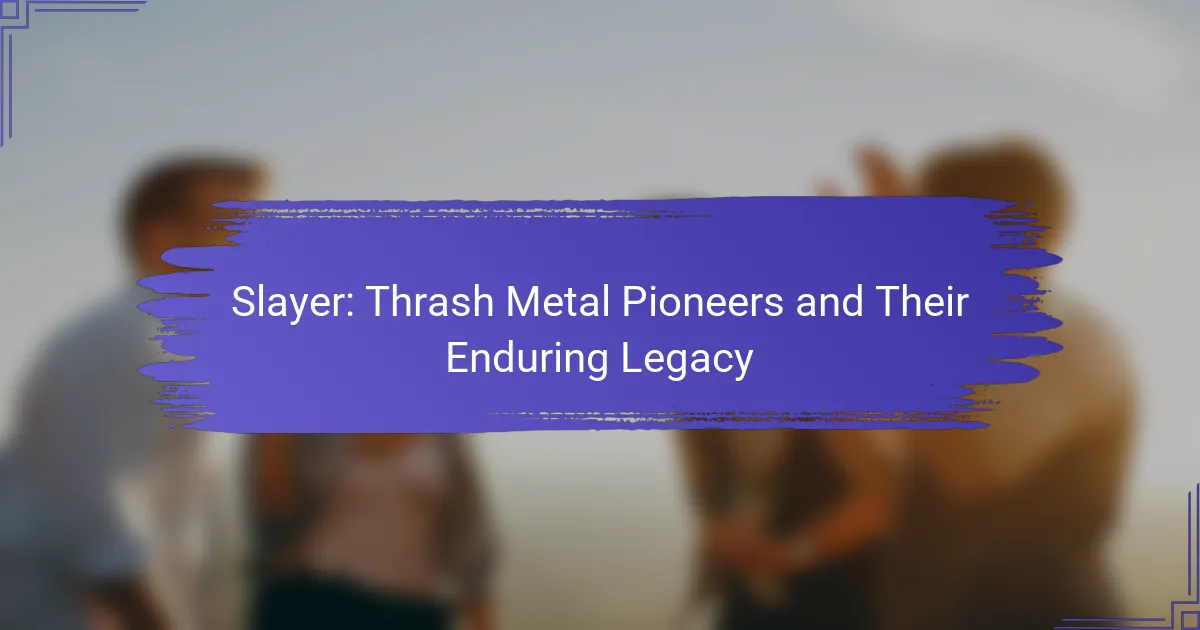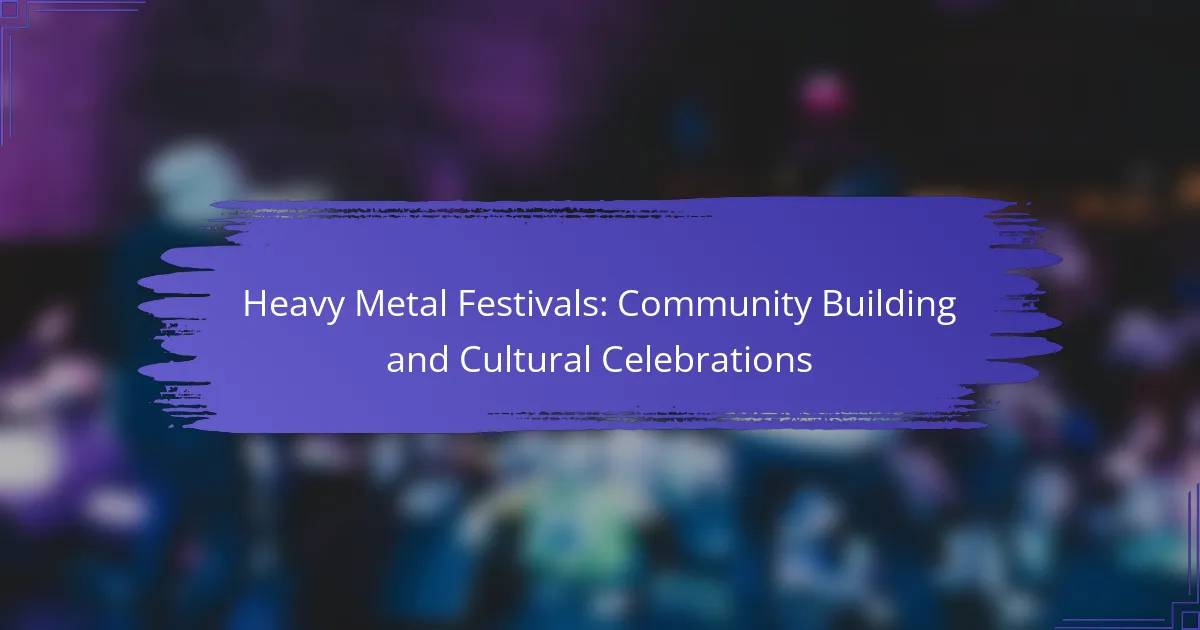Metallica has profoundly influenced heavy metal culture and music evolution through their aggressive sound and complex compositions. Their early albums established thrash metal as a subgenre and set new standards for technical prowess. The band’s exploration of personal and societal themes in lyrics deepened emotional connections with fans. Additionally, their collaborations and global fanbase reflect their lasting impact on the genre.

How did Metallica shape the sound of heavy metal music?
Metallica significantly shaped heavy metal music by introducing speed, aggression, and complex compositions. Their 1983 album “Kill ‘Em All” established thrash metal as a subgenre, influencing countless bands. The band’s innovative use of double bass drumming and intricate guitar solos set new standards for technical prowess in heavy metal. Additionally, their lyrical themes often explore personal and societal issues, adding depth to the genre. As a result, Metallica’s impact extends beyond music, as they have become cultural icons, shaping the identity of heavy metal itself.
What musical elements define Metallica’s style?
Metallica’s style is defined by heavy guitar riffs, complex song structures, and aggressive drumming. Their music incorporates elements of thrash, speed metal, and melodic harmonies. Unique attributes include intricate solos and socially conscious lyrics. Their innovative use of dynamics and tempo changes has significantly influenced the heavy metal genre.
Which albums marked pivotal moments in their evolution?
Metallica’s pivotal albums include “Kill ‘Em All,” “Master of Puppets,” and “The Black Album.” “Kill ‘Em All” established thrash metal’s aggressive sound. “Master of Puppets” showcased complex compositions and lyrical depth, solidifying their influence. “The Black Album” broadened their appeal, featuring mainstream hits. Each album marked a distinct evolution in their style and heavy metal’s trajectory.

What cultural impact did Metallica have on heavy metal communities?
Metallica significantly shaped heavy metal culture by influencing musical styles, fan communities, and the genre’s mainstream acceptance. Their aggressive sound and complex compositions introduced elements that expanded heavy metal’s boundaries.
The band’s incorporation of diverse musical influences, such as punk and classical, created a unique sound that resonated with a wide audience. This innovation led to the emergence of subgenres like thrash metal, inspiring countless bands.
Metallica’s lyrics often explore themes of personal struggle, societal issues, and existentialism, which deepened the emotional connection with fans. Their commitment to authenticity and artistic integrity fostered a loyal following, uniting fans across generations.
Through landmark albums like “Master of Puppets” and “The Black Album,” Metallica not only achieved commercial success but also elevated heavy metal to a prominent position in popular music. Their cultural impact continues to inspire artists and shape the heavy metal community today.
How did Metallica influence fashion and lifestyle within the genre?
Metallica significantly influenced fashion and lifestyle within the heavy metal genre by popularizing a distinct aesthetic. Their signature looks included leather jackets, band t-shirts, and long hairstyles, which became symbols of rebellion and identity for fans.
The band’s embrace of dark themes and aggressive imagery shaped merchandise trends, leading to the rise of graphic tees and patches. Additionally, Metallica’s concerts often featured a raw, energetic atmosphere that encouraged fans to express themselves through their clothing choices.
As a result, Metallica’s impact extended beyond music, creating a cultural movement that defined the heavy metal lifestyle. Their influence is evident in contemporary fashion trends that continue to draw from their iconic style.
What role did Metallica play in the rise of metal festivals?
Metallica played a crucial role in the rise of metal festivals by popularizing the genre and setting performance standards. Their participation in iconic events like the Monsters of Rock and Ozzfest drew massive crowds and elevated the visibility of heavy metal music. As a result, they influenced the structure and organization of metal festivals, making them a staple in the music scene. Their energetic performances and dedicated fan base helped establish a culture where metal festivals became essential for fans to experience live music.

How has Metallica’s lyrical content evolved over the years?
Metallica’s lyrical content has evolved from themes of personal struggle and societal issues to exploring complex narratives and introspection. Early albums focused on anger and rebellion, while later works incorporate deeper emotional and philosophical reflections. This shift highlights their growth as artists and their impact on heavy metal culture. The unique attribute of their later lyrics is the incorporation of storytelling elements, which adds depth to their music. Over time, Metallica has influenced the lyrical direction of many heavy metal bands.
What themes are prevalent in Metallica’s early lyrics?
Metallica’s early lyrics often explore themes of alienation, inner turmoil, and societal issues. The band addresses feelings of isolation, reflecting personal struggles and broader existential questions. Their lyrics also critique authority and war, showcasing a rebellious spirit. The intensity of these themes contributed significantly to the evolution of heavy metal, influencing countless artists and shaping the genre’s identity.
How do recent songs reflect contemporary issues?
Recent songs often address contemporary issues through themes of social justice, mental health, and political unrest. Metallica’s influence on heavy metal culture mirrors this evolution, as their lyrics frequently tackle personal and societal struggles. For example, their song “One” highlights the horrors of war, reflecting the anti-war sentiment of its time.
The band’s music has evolved to include commentary on addiction and isolation, resonating with listeners facing similar challenges today. Metallica’s ability to adapt their sound while maintaining a focus on relevant themes demonstrates their continued relevance in a changing musical landscape. Their impact on heavy metal is marked by a blend of aggression and introspection, shaping the genre’s narrative to encompass broader societal concerns.

Which unique collaborations has Metallica engaged in?
Metallica has engaged in unique collaborations with various artists, enhancing their musical impact. Notable collaborations include their work with Lou Reed on the album “Lulu,” which fused heavy metal with avant-garde rock. They also partnered with the San Francisco Symphony for the acclaimed “S&M” concert, blending orchestral music with their heavy metal sound. Additionally, Metallica collaborated with other rock legends like Ozzy Osbourne and members of the band Anthrax, showcasing their versatility and influence across genres. These collaborations highlight Metallica’s commitment to evolving music and cultural boundaries.
How did their collaboration with the San Francisco Symphony change perceptions of metal?
Metallica’s collaboration with the San Francisco Symphony significantly broadened perceptions of metal music. This partnership showcased heavy metal’s artistic depth and complexity, merging orchestral elements with traditional metal sounds. The live performance of “S&M” highlighted the genre’s versatility, attracting a wider audience and elevating its status in the music industry. As a result, it challenged stereotypes, demonstrating that metal can coexist with classical music, thus reshaping cultural views on the genre.
What impact did guest appearances with other artists have on their legacy?
Guest appearances with other artists significantly enhanced Metallica’s legacy by broadening their influence and showcasing their versatility. Collaborations with diverse musicians, such as their work with Lou Reed on “Lulu,” introduced them to new audiences and genres. This willingness to experiment helped solidify their status as heavy metal innovators. Additionally, their participation in events like the “Big Four” concerts with Slayer, Megadeth, and Anthrax reinforced their leadership role in the thrash metal scene. Such interactions not only enriched their musical repertoire but also fostered a sense of community within the heavy metal culture.

How does Metallica’s fanbase differ across regions?
Metallica’s fanbase varies significantly across regions due to cultural influences, music accessibility, and local heavy metal scenes. In North America, the fanbase is large and diverse, often characterized by a strong presence at live events. In Europe, particularly in countries like Germany and Sweden, fans exhibit deep loyalty and engagement, often participating in festivals. Latin America shows a passionate following, with fans celebrating the band’s music as a symbol of rebellion. Asia, particularly Japan, has a unique appreciation for Metallica’s technical prowess, leading to a dedicated yet smaller fanbase. Each region’s interaction with Metallica reflects local values and musical heritage, showcasing the band’s global impact on heavy metal culture.
What are the characteristics of Metallica’s Canadian fanbase?
Metallica’s Canadian fanbase is characterized by deep loyalty, diverse demographics, and active participation in concerts. The fans range from young adults to older generations, showcasing a unique blend of cultures and backgrounds. Canadian fans often express their passion through merchandise, fan gatherings, and social media engagement. The band’s influence on heavy metal culture resonates strongly, as evidenced by the numerous tribute bands and local metal scenes inspired by their music. Additionally, the unique attribute of Canada’s vast geography results in fans traveling long distances to attend live shows, emphasizing their dedication.
How do UK fans engage with Metallica compared to US fans?
UK fans engage with Metallica through distinct cultural expressions compared to US fans. UK audiences often emphasize community and local music scenes, fostering a sense of belonging. In contrast, US fans typically showcase individualism and larger concert experiences.
UK Metallica fans frequently participate in fan clubs and local events, enhancing their connection to the band. They celebrate the band’s influence on the UK heavy metal scene, often attending smaller, more intimate shows. US fans, however, tend to gravitate toward massive festivals and stadium tours, reflecting a broader market presence.
Social media engagement reveals differences as well. UK fans often share personal stories and experiences related to the band’s impact on their lives, while US fans focus on concert footage and merchandise. These engagement patterns highlight the unique attributes of fan culture in each region, showcasing how Metallica resonates differently across the Atlantic.

What rare attributes contribute to Metallica’s enduring legacy?
Metallica’s enduring legacy is shaped by their unique ability to blend musical innovation with cultural impact. Their pioneering sound, characterized by intricate guitar riffs and aggressive rhythms, set a new standard in heavy metal. The band’s commitment to social issues, such as anti-establishment themes and personal struggles, resonates deeply with fans. Additionally, their rare attribute of consistently evolving their music style while maintaining core elements has attracted diverse audiences. Their influence extends beyond music, inspiring generations of artists and shaping the heavy metal genre’s identity.
Which philanthropic efforts has Metallica undertaken?
Metallica has undertaken various philanthropic efforts, primarily through their All Within My Hands Foundation. This foundation focuses on workforce education, hunger relief, and supporting sustainable communities. Since its inception, it has donated millions to various causes, including disaster relief and music education programs. Notable initiatives include partnerships with food banks and funding for scholarships in music programs. Their commitment to social responsibility enhances their legacy within heavy metal culture.
How has Metallica’s business acumen influenced their longevity?
Metallica’s business acumen has significantly contributed to their enduring success in the music industry. Strategic decisions in marketing, merchandise, and touring have solidified their brand.
They pioneered direct-to-fan sales, enhancing revenue through exclusive content and experiences. Their adaptability to changing music consumption trends, such as embracing digital platforms, has kept them relevant.
Additionally, their commitment to quality and innovation in music production has attracted a loyal fanbase. This combination of savvy business practices and artistic integrity has ensured Metallica’s longevity in heavy metal culture.

What practical strategies can fans use to connect with Metallica’s music?
Fans can connect with Metallica’s music through various practical strategies. Listening to their albums in chronological order reveals the band’s evolution and influences. Attending live concerts enhances the experience, allowing fans to engage with the energy and community. Joining fan clubs or online forums fosters connections with fellow enthusiasts, sharing insights and experiences. Learning to play their songs on instruments deepens appreciation and understanding of their musical complexity. Exploring interviews and documentaries provides context about their impact on heavy metal culture.
How can listeners explore Metallica’s discography effectively?
Listeners can explore Metallica’s discography effectively by focusing on key albums and their evolution. Start with “Kill ‘Em All” and progress through “Master of Puppets” to understand their early thrash metal roots.
Next, delve into “The Black Album,” which marked a shift toward mainstream appeal, featuring hits like “Enter Sandman.” Explore later works like “Death Magnetic” and “Hardwired… to Self-Destruct” to see their modern sound and lyrical depth.
Engaging with live performances and documentaries enhances understanding of their impact on heavy metal culture. Analyzing lyrics reveals themes of personal struggle and societal issues, showcasing their unique attribute of storytelling through music.
Finally, consider joining fan forums or playlists that highlight essential tracks for a comprehensive listening experience. This approach provides a structured way to appreciate Metallica’s influence and musical evolution.
What are the best practices for attending a Metallica concert?
To attend a Metallica concert successfully, prioritize preparation and engagement. Arrive early to secure a good spot, and familiarize yourself with the venue layout. Wear comfortable clothing and shoes, as concerts can be physically demanding. Stay hydrated and consider ear protection due to high volume levels. Engage with fellow fans to enhance the experience, and be respectful of the band’s performance space. Lastly, capture memories responsibly; avoid obstructing others’ views while taking photos.



